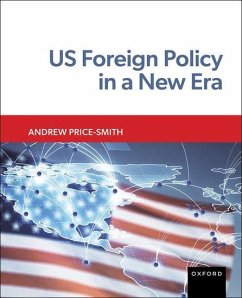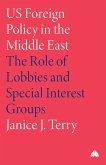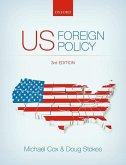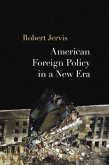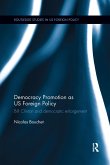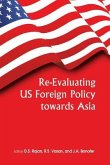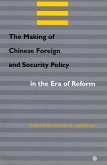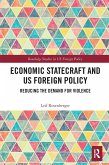Andrew Price-Smith
US Foreign Policy in a New Era
Andrew Price-Smith
US Foreign Policy in a New Era
- Broschiertes Buch
- Merkliste
- Auf die Merkliste
- Bewerten Bewerten
- Teilen
- Produkt teilen
- Produkterinnerung
- Produkterinnerung
An accessible introduction to US Foreign Policy for undergraduate students, providing a comprehensive examination of historical context and contemporary events, and featuring a unique emphasis on transnational issues such as global health and the environment.
Andere Kunden interessierten sich auch für
![US Foreign Policy in the Middle East US Foreign Policy in the Middle East]() Janice J. TerryUS Foreign Policy in the Middle East39,99 €
Janice J. TerryUS Foreign Policy in the Middle East39,99 €![US Foreign Policy US Foreign Policy]() US Foreign Policy65,99 €
US Foreign Policy65,99 €![American Foreign Policy in a New Era American Foreign Policy in a New Era]() Robert JervisAmerican Foreign Policy in a New Era55,99 €
Robert JervisAmerican Foreign Policy in a New Era55,99 €![Democracy Promotion as US Foreign Policy Democracy Promotion as US Foreign Policy]() Nicolas BouchetDemocracy Promotion as US Foreign Policy60,99 €
Nicolas BouchetDemocracy Promotion as US Foreign Policy60,99 €![Re-Evaluating Us Foreign Policy Towards Asia Re-Evaluating Us Foreign Policy Towards Asia]() Re-Evaluating Us Foreign Policy Towards Asia42,99 €
Re-Evaluating Us Foreign Policy Towards Asia42,99 €![The Making of Chinese Foreign and Security Policy in the Era of Reform The Making of Chinese Foreign and Security Policy in the Era of Reform]() The Making of Chinese Foreign and Security Policy in the Era of Reform39,99 €
The Making of Chinese Foreign and Security Policy in the Era of Reform39,99 €![Economic Statecraft and US Foreign Policy Economic Statecraft and US Foreign Policy]() Leif RosenbergerEconomic Statecraft and US Foreign Policy60,99 €
Leif RosenbergerEconomic Statecraft and US Foreign Policy60,99 €-
-
-
An accessible introduction to US Foreign Policy for undergraduate students, providing a comprehensive examination of historical context and contemporary events, and featuring a unique emphasis on transnational issues such as global health and the environment.
Hinweis: Dieser Artikel kann nur an eine deutsche Lieferadresse ausgeliefert werden.
Hinweis: Dieser Artikel kann nur an eine deutsche Lieferadresse ausgeliefert werden.
Produktdetails
- Produktdetails
- Verlag: Oxford University Press Inc
- Seitenzahl: 416
- Erscheinungstermin: 19. Dezember 2023
- Englisch
- Abmessung: 198mm x 226mm x 36mm
- Gewicht: 703g
- ISBN-13: 9780190465988
- ISBN-10: 0190465980
- Artikelnr.: 68538236
- Verlag: Oxford University Press Inc
- Seitenzahl: 416
- Erscheinungstermin: 19. Dezember 2023
- Englisch
- Abmessung: 198mm x 226mm x 36mm
- Gewicht: 703g
- ISBN-13: 9780190465988
- ISBN-10: 0190465980
- Artikelnr.: 68538236
Andrew Price-Smith was a leading scholar of global health security and the David Packard Professor of International Relations and Director of the Global Health Initiative at Colorado College. Price-Smith specialized in analyses of the effects of disease, environmental change, and energy scarcity on the security of nations. He was the author of numerous books and articles, including Rising Threats, Enduring Challenges (OUP) and Oil, Illiberalism, and War; Contagion and Chaos; and The Health of Nations (MIT Press).
Chapter 1: Origins and History of the International System
1.1 Origins of the International System
1.2 Reformation and War
1.3 Imperialism
1.4 The Making of the Modern State
1.5 The Perils of Anarchy
Chapter 2: The Cold War
2.1 The Rise of the United Nations
2.2 Containment
2.3 NSC-68
2.4 Domino Theory
2.5 Guatemala
2.6 The Cuban Missile Crisis, 1962
2.7 The Vietnam War
2.8 Nuclear Deterrence and Arms Control
2.9 SALT and the ABM Treaty
2.10 Nixon's Opening to China and Efforts in the Persian Gulf
2.11 The Carter Doctrine
2.12 The Reagan Doctrine
2.13 The Strategic Defense Initiative: SDI
2.14 The End of the Cold War
2.15 Triumph of the West
2.16 Gorbachev as an Agent of Change
2.17 Finding a Path: from What? to Why?
Chapter 3: The Three Branches of Government and US Foreign Policy
3.1 Shared War Powers
3.2 The Executive Branch: Powers of the Presidency
3.3 Limits to Presidential Power
3.4 Presidential Advisors and Executive Institutions
3.5 Congressional Power and Foreign Policy Budgetary Powers
3.6 The Role of the Judiciary
Chapter 4: Foreign Policy Decisions and the Question of Leadership
4.1 The Psyche of the President
4.2 The Influence of Ideas Upon Foreign Policy
4.3 Bounded Rationality
4.4 Operational Codes
4.5 Attribution Theory
4.6 Heuristics
4.7 The Bureaucratic Politics Paradigm
4.8 The Operational Process Paradigm
4.9 Presidents as Leaders
Chapter 5: External Influences on US Foreign Policy
5.1 Foreign Governments
5.2 Political Issue Groups
5.3 Economic Issue Groups
5.4 Identity-based Groups
5.5 Politics and the Media
5.6 Media and Foreign Policy
5.7 Fake News
5.8 Public Opinion
5.9 US Health Security
Chapter 6: International Political Economy
6.1 The Great Depression
6.2 The Bretton Woods System
6.3 The Marshall Plan
6.4 The European Coal and Steel Community (ECSC)
6.5 The Washington Consensus
6.6 The GATT and the World Trade Organization
6.7 North American Free Trade Agreement (NAFTA)
6.8 Central American Free Trade Agreement (CAFTA)
6.9 Trans Pacific Partnership (TPP)
6.10 The Political Economy of US Foreign Aid
6.11 The World Bank and the International Monetary Fund
6.12 The Great Recession of 2008-10
6.13 The Era of Globalization
6.14 Declining Public Support for Free-Trade and Foreign Aid
Chapter 7: The Era of Transformation (1991-2007)
7.1 The Unipolar Moment
7.2 Operation Desert Storm (1990-91)
7.3 Somalia (1992)
7.4 The Clinton Years
7.5 The G.W. Bush Years
Chapter 8: The Era of Retrenchment (2008-)
8.1 The Obama Administration (2008-16)
8.2 The Trump Administration (2017-2021)
8.3 The Biden Administration (2021-)
Chapter 9: US-Russian Relations
9.1 Post-Cold War and 9/11
9.2 NATO and EU Enlargement
9.3 The Invasion of Georgia, 2008
9.4 Obama's "Middle Way"
9.5 Russian Aggression in Crimea
9.6 The New Cold War?
9.7 Russian Invasion of Ukraine
9.8 "The Fault of the West"
9.9 Russian Neo-Imperialism
9.10 Levers of Power: Russia and Energy in Foreign Policy
9.11 The Future of US-Russia Relations
Chapter 10: China and the US
10.1 The Korean War
10.2 Nixon's Opening to China (1969-72)
10.3 Tiananmen Square Massacre, 1989
10.4 New Tensions
10.5 The Xi Era
10.6 Beijing's Perspective on Security
10.7 The Security Dilemma in East Asia
10.8 Energy
Chapter 11: Terrorism
11.1 The Rise of Al Qaeda
11.2 The Islamic State
11.3 The War on Terror
11.4 Authorization of the War on Terror
11.5 Problems with the War on Terror
11.6 Liberty vs. Security
11.7 US Strategy
Chapter 12: Climate Change and US Foreign Policy
12.1 Scope of the Problem
12.2 Temperature
12.3 Is Climate Change Occurring?
12.4 Climate Change Governance
12.5 Public Goods and Free-Riding
12.6 The Problem of Two-Level Games for the Climate
12.7 The Paris Agreement: Symbol or Substance?
1.1 Origins of the International System
1.2 Reformation and War
1.3 Imperialism
1.4 The Making of the Modern State
1.5 The Perils of Anarchy
Chapter 2: The Cold War
2.1 The Rise of the United Nations
2.2 Containment
2.3 NSC-68
2.4 Domino Theory
2.5 Guatemala
2.6 The Cuban Missile Crisis, 1962
2.7 The Vietnam War
2.8 Nuclear Deterrence and Arms Control
2.9 SALT and the ABM Treaty
2.10 Nixon's Opening to China and Efforts in the Persian Gulf
2.11 The Carter Doctrine
2.12 The Reagan Doctrine
2.13 The Strategic Defense Initiative: SDI
2.14 The End of the Cold War
2.15 Triumph of the West
2.16 Gorbachev as an Agent of Change
2.17 Finding a Path: from What? to Why?
Chapter 3: The Three Branches of Government and US Foreign Policy
3.1 Shared War Powers
3.2 The Executive Branch: Powers of the Presidency
3.3 Limits to Presidential Power
3.4 Presidential Advisors and Executive Institutions
3.5 Congressional Power and Foreign Policy Budgetary Powers
3.6 The Role of the Judiciary
Chapter 4: Foreign Policy Decisions and the Question of Leadership
4.1 The Psyche of the President
4.2 The Influence of Ideas Upon Foreign Policy
4.3 Bounded Rationality
4.4 Operational Codes
4.5 Attribution Theory
4.6 Heuristics
4.7 The Bureaucratic Politics Paradigm
4.8 The Operational Process Paradigm
4.9 Presidents as Leaders
Chapter 5: External Influences on US Foreign Policy
5.1 Foreign Governments
5.2 Political Issue Groups
5.3 Economic Issue Groups
5.4 Identity-based Groups
5.5 Politics and the Media
5.6 Media and Foreign Policy
5.7 Fake News
5.8 Public Opinion
5.9 US Health Security
Chapter 6: International Political Economy
6.1 The Great Depression
6.2 The Bretton Woods System
6.3 The Marshall Plan
6.4 The European Coal and Steel Community (ECSC)
6.5 The Washington Consensus
6.6 The GATT and the World Trade Organization
6.7 North American Free Trade Agreement (NAFTA)
6.8 Central American Free Trade Agreement (CAFTA)
6.9 Trans Pacific Partnership (TPP)
6.10 The Political Economy of US Foreign Aid
6.11 The World Bank and the International Monetary Fund
6.12 The Great Recession of 2008-10
6.13 The Era of Globalization
6.14 Declining Public Support for Free-Trade and Foreign Aid
Chapter 7: The Era of Transformation (1991-2007)
7.1 The Unipolar Moment
7.2 Operation Desert Storm (1990-91)
7.3 Somalia (1992)
7.4 The Clinton Years
7.5 The G.W. Bush Years
Chapter 8: The Era of Retrenchment (2008-)
8.1 The Obama Administration (2008-16)
8.2 The Trump Administration (2017-2021)
8.3 The Biden Administration (2021-)
Chapter 9: US-Russian Relations
9.1 Post-Cold War and 9/11
9.2 NATO and EU Enlargement
9.3 The Invasion of Georgia, 2008
9.4 Obama's "Middle Way"
9.5 Russian Aggression in Crimea
9.6 The New Cold War?
9.7 Russian Invasion of Ukraine
9.8 "The Fault of the West"
9.9 Russian Neo-Imperialism
9.10 Levers of Power: Russia and Energy in Foreign Policy
9.11 The Future of US-Russia Relations
Chapter 10: China and the US
10.1 The Korean War
10.2 Nixon's Opening to China (1969-72)
10.3 Tiananmen Square Massacre, 1989
10.4 New Tensions
10.5 The Xi Era
10.6 Beijing's Perspective on Security
10.7 The Security Dilemma in East Asia
10.8 Energy
Chapter 11: Terrorism
11.1 The Rise of Al Qaeda
11.2 The Islamic State
11.3 The War on Terror
11.4 Authorization of the War on Terror
11.5 Problems with the War on Terror
11.6 Liberty vs. Security
11.7 US Strategy
Chapter 12: Climate Change and US Foreign Policy
12.1 Scope of the Problem
12.2 Temperature
12.3 Is Climate Change Occurring?
12.4 Climate Change Governance
12.5 Public Goods and Free-Riding
12.6 The Problem of Two-Level Games for the Climate
12.7 The Paris Agreement: Symbol or Substance?
Chapter 1: Origins and History of the International System
1.1 Origins of the International System
1.2 Reformation and War
1.3 Imperialism
1.4 The Making of the Modern State
1.5 The Perils of Anarchy
Chapter 2: The Cold War
2.1 The Rise of the United Nations
2.2 Containment
2.3 NSC-68
2.4 Domino Theory
2.5 Guatemala
2.6 The Cuban Missile Crisis, 1962
2.7 The Vietnam War
2.8 Nuclear Deterrence and Arms Control
2.9 SALT and the ABM Treaty
2.10 Nixon's Opening to China and Efforts in the Persian Gulf
2.11 The Carter Doctrine
2.12 The Reagan Doctrine
2.13 The Strategic Defense Initiative: SDI
2.14 The End of the Cold War
2.15 Triumph of the West
2.16 Gorbachev as an Agent of Change
2.17 Finding a Path: from What? to Why?
Chapter 3: The Three Branches of Government and US Foreign Policy
3.1 Shared War Powers
3.2 The Executive Branch: Powers of the Presidency
3.3 Limits to Presidential Power
3.4 Presidential Advisors and Executive Institutions
3.5 Congressional Power and Foreign Policy Budgetary Powers
3.6 The Role of the Judiciary
Chapter 4: Foreign Policy Decisions and the Question of Leadership
4.1 The Psyche of the President
4.2 The Influence of Ideas Upon Foreign Policy
4.3 Bounded Rationality
4.4 Operational Codes
4.5 Attribution Theory
4.6 Heuristics
4.7 The Bureaucratic Politics Paradigm
4.8 The Operational Process Paradigm
4.9 Presidents as Leaders
Chapter 5: External Influences on US Foreign Policy
5.1 Foreign Governments
5.2 Political Issue Groups
5.3 Economic Issue Groups
5.4 Identity-based Groups
5.5 Politics and the Media
5.6 Media and Foreign Policy
5.7 Fake News
5.8 Public Opinion
5.9 US Health Security
Chapter 6: International Political Economy
6.1 The Great Depression
6.2 The Bretton Woods System
6.3 The Marshall Plan
6.4 The European Coal and Steel Community (ECSC)
6.5 The Washington Consensus
6.6 The GATT and the World Trade Organization
6.7 North American Free Trade Agreement (NAFTA)
6.8 Central American Free Trade Agreement (CAFTA)
6.9 Trans Pacific Partnership (TPP)
6.10 The Political Economy of US Foreign Aid
6.11 The World Bank and the International Monetary Fund
6.12 The Great Recession of 2008-10
6.13 The Era of Globalization
6.14 Declining Public Support for Free-Trade and Foreign Aid
Chapter 7: The Era of Transformation (1991-2007)
7.1 The Unipolar Moment
7.2 Operation Desert Storm (1990-91)
7.3 Somalia (1992)
7.4 The Clinton Years
7.5 The G.W. Bush Years
Chapter 8: The Era of Retrenchment (2008-)
8.1 The Obama Administration (2008-16)
8.2 The Trump Administration (2017-2021)
8.3 The Biden Administration (2021-)
Chapter 9: US-Russian Relations
9.1 Post-Cold War and 9/11
9.2 NATO and EU Enlargement
9.3 The Invasion of Georgia, 2008
9.4 Obama's "Middle Way"
9.5 Russian Aggression in Crimea
9.6 The New Cold War?
9.7 Russian Invasion of Ukraine
9.8 "The Fault of the West"
9.9 Russian Neo-Imperialism
9.10 Levers of Power: Russia and Energy in Foreign Policy
9.11 The Future of US-Russia Relations
Chapter 10: China and the US
10.1 The Korean War
10.2 Nixon's Opening to China (1969-72)
10.3 Tiananmen Square Massacre, 1989
10.4 New Tensions
10.5 The Xi Era
10.6 Beijing's Perspective on Security
10.7 The Security Dilemma in East Asia
10.8 Energy
Chapter 11: Terrorism
11.1 The Rise of Al Qaeda
11.2 The Islamic State
11.3 The War on Terror
11.4 Authorization of the War on Terror
11.5 Problems with the War on Terror
11.6 Liberty vs. Security
11.7 US Strategy
Chapter 12: Climate Change and US Foreign Policy
12.1 Scope of the Problem
12.2 Temperature
12.3 Is Climate Change Occurring?
12.4 Climate Change Governance
12.5 Public Goods and Free-Riding
12.6 The Problem of Two-Level Games for the Climate
12.7 The Paris Agreement: Symbol or Substance?
1.1 Origins of the International System
1.2 Reformation and War
1.3 Imperialism
1.4 The Making of the Modern State
1.5 The Perils of Anarchy
Chapter 2: The Cold War
2.1 The Rise of the United Nations
2.2 Containment
2.3 NSC-68
2.4 Domino Theory
2.5 Guatemala
2.6 The Cuban Missile Crisis, 1962
2.7 The Vietnam War
2.8 Nuclear Deterrence and Arms Control
2.9 SALT and the ABM Treaty
2.10 Nixon's Opening to China and Efforts in the Persian Gulf
2.11 The Carter Doctrine
2.12 The Reagan Doctrine
2.13 The Strategic Defense Initiative: SDI
2.14 The End of the Cold War
2.15 Triumph of the West
2.16 Gorbachev as an Agent of Change
2.17 Finding a Path: from What? to Why?
Chapter 3: The Three Branches of Government and US Foreign Policy
3.1 Shared War Powers
3.2 The Executive Branch: Powers of the Presidency
3.3 Limits to Presidential Power
3.4 Presidential Advisors and Executive Institutions
3.5 Congressional Power and Foreign Policy Budgetary Powers
3.6 The Role of the Judiciary
Chapter 4: Foreign Policy Decisions and the Question of Leadership
4.1 The Psyche of the President
4.2 The Influence of Ideas Upon Foreign Policy
4.3 Bounded Rationality
4.4 Operational Codes
4.5 Attribution Theory
4.6 Heuristics
4.7 The Bureaucratic Politics Paradigm
4.8 The Operational Process Paradigm
4.9 Presidents as Leaders
Chapter 5: External Influences on US Foreign Policy
5.1 Foreign Governments
5.2 Political Issue Groups
5.3 Economic Issue Groups
5.4 Identity-based Groups
5.5 Politics and the Media
5.6 Media and Foreign Policy
5.7 Fake News
5.8 Public Opinion
5.9 US Health Security
Chapter 6: International Political Economy
6.1 The Great Depression
6.2 The Bretton Woods System
6.3 The Marshall Plan
6.4 The European Coal and Steel Community (ECSC)
6.5 The Washington Consensus
6.6 The GATT and the World Trade Organization
6.7 North American Free Trade Agreement (NAFTA)
6.8 Central American Free Trade Agreement (CAFTA)
6.9 Trans Pacific Partnership (TPP)
6.10 The Political Economy of US Foreign Aid
6.11 The World Bank and the International Monetary Fund
6.12 The Great Recession of 2008-10
6.13 The Era of Globalization
6.14 Declining Public Support for Free-Trade and Foreign Aid
Chapter 7: The Era of Transformation (1991-2007)
7.1 The Unipolar Moment
7.2 Operation Desert Storm (1990-91)
7.3 Somalia (1992)
7.4 The Clinton Years
7.5 The G.W. Bush Years
Chapter 8: The Era of Retrenchment (2008-)
8.1 The Obama Administration (2008-16)
8.2 The Trump Administration (2017-2021)
8.3 The Biden Administration (2021-)
Chapter 9: US-Russian Relations
9.1 Post-Cold War and 9/11
9.2 NATO and EU Enlargement
9.3 The Invasion of Georgia, 2008
9.4 Obama's "Middle Way"
9.5 Russian Aggression in Crimea
9.6 The New Cold War?
9.7 Russian Invasion of Ukraine
9.8 "The Fault of the West"
9.9 Russian Neo-Imperialism
9.10 Levers of Power: Russia and Energy in Foreign Policy
9.11 The Future of US-Russia Relations
Chapter 10: China and the US
10.1 The Korean War
10.2 Nixon's Opening to China (1969-72)
10.3 Tiananmen Square Massacre, 1989
10.4 New Tensions
10.5 The Xi Era
10.6 Beijing's Perspective on Security
10.7 The Security Dilemma in East Asia
10.8 Energy
Chapter 11: Terrorism
11.1 The Rise of Al Qaeda
11.2 The Islamic State
11.3 The War on Terror
11.4 Authorization of the War on Terror
11.5 Problems with the War on Terror
11.6 Liberty vs. Security
11.7 US Strategy
Chapter 12: Climate Change and US Foreign Policy
12.1 Scope of the Problem
12.2 Temperature
12.3 Is Climate Change Occurring?
12.4 Climate Change Governance
12.5 Public Goods and Free-Riding
12.6 The Problem of Two-Level Games for the Climate
12.7 The Paris Agreement: Symbol or Substance?
